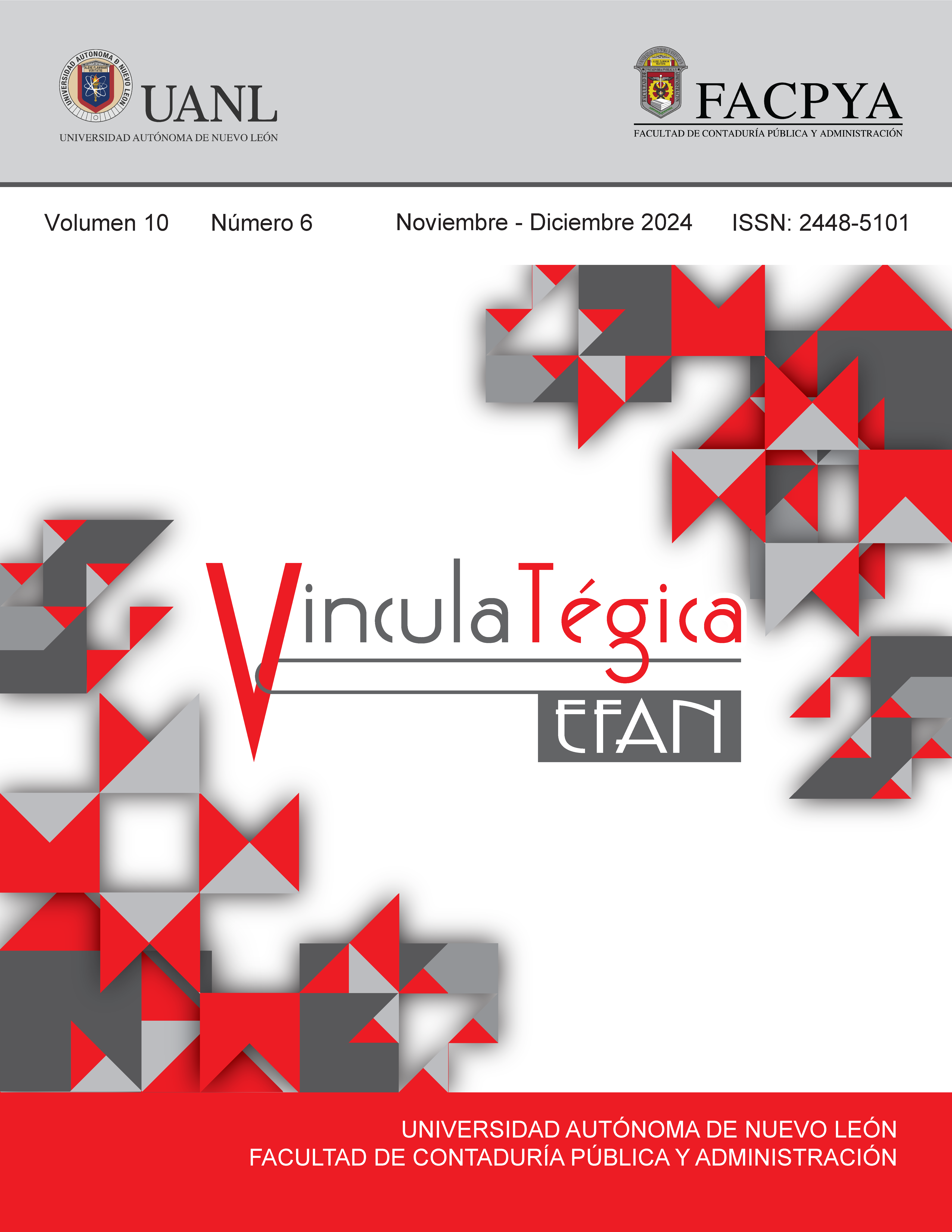The Business Strategy Game: Implementation of a balanced scorecard
DOI:
https://doi.org/10.29105/vtga10.6-1005Keywords:
balanced scorecard, business simulator, The Business Strategy GameAbstract
Organizational strategists must perform professionally to achieve the maximum possible efficiency and effectiveness in all actions carried out, which must be reflected in the adequate management of the competitive advantages of the managed entity and, in this way, overcome the various challenges and adversities intrinsic to them. its environment. Therefore, the central objective of the work carried out is the design of the balanced scorecard (BSC) of a virtual business (ALFA company) through the use of the specialized decision-making software The Business Strategy Game (BSG). Likewise, it was decided to use the specialized decision-making software The Business Strategy Game. (BSG). This electronic business package was chosen because it was widely used globally, both in organizations to train management staff and in Higher Education Institutions. The results obtained from the developed BSC can be capitalized as a practical resource to exemplify the choice of the most appropriate indicators in the measurement and evaluation of the financial and non-financial organizational aspects, that is, the tangible and intangible resources that are equally important to achieve the expected success.
Downloads
References
Alves, D., Ferraz, O., Chiari, E. C., Ofenhjem, A. y Goncalves, W. A. (2014). La dinámica de la perspectiva aprendizaje y crecimiento del BSC en el constexto de la planificación estratégica de una fábrica alemana del sector automotriz. Invenio, 17(33), 87-10. En: https://dialnet.unirioja.es/servlet/articulo?codigo=4842023
Aragón-Sánchez, A. y Sánchez-Marín, G. (2005). Strategic Orientation, Management Characteristics, and Performance: A Study of Spanish SMEs. Journal of Small Business Management, 43(3), 287-308. https://doi.org/10.1111/j.1540-627X.2005.00138.x DOI: https://doi.org/10.1111/j.1540-627X.2005.00138.x
Arango-Pastrana, C., Osorio-Andrade, C., y Arango-Espinal, E. (2021). eWOM en los tiempos de la COVID-19: un análisis empírico de marcas colombianas en Facebook. Estudios Gerenciales, 37(158), 28-36. https://doi.org/10.18046/j.estger.2021.158.4267 DOI: https://doi.org/10.18046/j.estger.2021.158.4267
Blanco, M., Aibar, B. y Cantorna, S. (1999). El enfoque conductual y su reflejo en un cuadro de mando integral. Revista Española de Financiación y Contabilidad, 28(98), 77-104. En: https://www.jstor.org/stable/42785210
Cárdenas, T. (2007). Cuadro de mando integral como una herramienta de planificación estratégica. Perspectivas, 1(19),75-92. En: https://www.redalyc.org/pdf/4259/425942453007.pdf
Cekuls, A. (2022). AI-Driven Competitive Intelligence: Enhancing Business Strategy and Decision Making. Journal of Intelligence Studies in Business, 12(3), 4-5. https://doi.org/10.37380/jisib.v12i3.961 DOI: https://doi.org/10.37380/jisib.v12i3.961
David, F. R. y David, F. R. (2017). Conceptos de administración estratégica. Pearson Educación.
Hitt, M. Ireland, R. y Hoskisson, R. (2008). Administración Estratégica. Competitividad y globalización. Conceptos y casos. Cengage Learning.
Huerta, P. Navas, J. y Almodóvar, P. (2004). La diversificación desde la teórica de recursos y capacidades. Cuadernos de estudios empresariales, 14(1), 87-104. En: https://dialnet.unirioja.es/servlet/articulo?codigo=1301196
Isoherranen, V. y Kess, P. (2011). Analysis of Strategy by Strategy Typology and Orientation Framework. Modern Economy, 2(4), 575-583. https://doi.org/10.4236/me.2011.24064 DOI: https://doi.org/10.4236/me.2011.24064
Kaplan, R. S. y Norton, D. P. (2001). Cómo utilizar el cuadro de mando integral: para implementar y gestionar su estrategia. Gestión 2000.
Kaplan, R. S. y Norton, D. P. (2002). Cuadro de mando integral (The balanced scorecard). Gestión 2000.
Kaplan, R. S. y Norton, D. P. (2008). The Execution Premium. Integrando la estrategia y operaciones para lograr ventajas competitivas. Ediciones Deusto.
Knott, P. (2006). A typology of strategy tool applications. Management Decision, 44(8), 1090-1105. https://doi.org/10.1108/00251740610690630 DOI: https://doi.org/10.1108/00251740610690630
Martín-Peña, M. L. y Díaz-Garrido, E. (2008). Typologies and taxonomies of operations strategy: a literature review. Management Research News, 31(3), 200-218. https://doi.org/10.1108/01409170810851294 DOI: https://doi.org/10.1108/01409170810851294
Mayfield, M., Mayfield, J. y Stephens, D. (2007). The relationship of generic strategy typing and organizational longevity: A preliminary analysis in the comic book industry using the Miles and Snow typology. Competitive Review: An International Business Journal, 17(1/2), 94-108. https://doi.org/10.1108/10595420710816641 DOI: https://doi.org/10.1108/10595420710816641
Muñoz, E.C. (2009). Cuadro de mando integral (balanced scorecard) para la gestión bibliotecaria: pautas para una aplicación. Investigación Bibliotecológica, 23(48), 105-126. En: https://www.scielo.org.mx/scielo.php?pid=S0187-358X2009000200005&script=sci_abstract DOI: https://doi.org/10.22201/iibi.0187358xp.2009.48.16971
Navas, J. y Guerras, L. (2002). La dirección estratégica de la empresa. Teoría y aplicaciones. Civitas.
Navas, J. y Ortiz, M. (2001). Gestión del conocimiento y capital intelectual: Algunos aspectos conceptuales. Cuadernos Aragoneses de Economía, 11(1), 35-48. En: https://www.redalyc.org/pdf/206/20611495005.pdf
Navas, J. y Ortiz, M. (2002). El capital intelectual en la empresa. Análisis de criterios y clasificación multidimensional. Economía industrial, 346, 163-171. En: https://dialnet.unirioja.es/servlet/articulo?codigo=716729
Netz, J., Brundin, E., y Svensson, M. (2020). Business disruptions and affective reactions: A strategy-as-practice perspective on fast strategic decision making. Long Range Planning, 53(5). https://doi.org/10.1016/j.lrp.2019.101910 DOI: https://doi.org/10.1016/j.lrp.2019.101910
Niven, P. R. (2003). El cuadro de mando integral paso a paso. Maximizar la gestión y mantener los resultados. Gestión 2000.
O’Regan, N. y Ghobadian, A. (2006). Perceptions of generic strategies of small and medium sized engineering and electronics manufacturers in the UK: The applicability of the Miles and Snow typology. Journal of Manufacturing Technology Management, 17(5), 603-620. https://doi.org/10.1108/17410380610668540 DOI: https://doi.org/10.1108/17410380610668540
Pérez, D. C. y Pirona, J. A. (2012). Perspectiva financiera y de clientes del cuadro de mando integral aplicadas a la gerencia media de la Universidad Nacional Experimental Francisco de Miranda (UNEFM). Multiciencias, 12(1), 158-163. En: https://www.redalyc.org/pdf/904/90431109025.pdf
Porter, M. (1980). Competitive Strategy, Free Press, New York, 1980.
Porter, M. (1982). Estrategia Competitiva, Técnicas para el Análisis de los Sectores Industriales y de la Competencia. CECSA.
Porter, M. (1987). From Competitive Advantage to Corporate Strategy. Harvard Business Review.
Porter, M. (1991). La ventaja competitiva de las naciones. Plaza & Janés.
Porter, M. (2002). Ventaja competitiva. Patria
Porter, M. E. (2009). Ventaja competitiva. Creación y sostenimiento de un desempeño superior. Grupo Editorial Patria.
Reed, R. y Defillippi, R. (1990). Causal amgibuity, barriers to imitation, and sustainable competitive advantage. Academy of Management Review, 15(1), 88-102. https://doi.org/10.2307/258107 DOI: https://doi.org/10.5465/amr.1990.4308277
Rodrigues, P., Aibar, B. y Lima, L. (2014). La adopción del cuadro de mando integral en organizaciones portuguesas: Variables contingentes e institucionales. Intangible Capital, 9(2),491-525. En: https://www.redalyc.org/pdf/549/54928232003.pdf
Stambaugh, J. E., Yu, A. y Dubinsky, A. J. (2011). Before the Attack: A Typology of Strategies for Competitive Aggressiveness. Journal of Management Policy and Practice, 12(1), 49-63. En: http://www.na-businesspress.com/JMPP/StambaughWeb.pdf
Strandskov, J. (2006). Sources of competitive advantages and business performance. Journal of Business Economics and Management, 7(3), 119, 129. https://doi.org/10.3846/16111699.2006.9636132 DOI: https://doi.org/10.3846/16111699.2006.9636132
Thompson, A. A., Stappenbeck, G. J., Reidenbach, M. A., Thrasher, I. F., y Harms, C. C. (2022a). The Business Strategy Game. Competing in a Global Marketplace: Instructor’s Guide. Mc Graw Hill Education
Thompson, A. A., Stappenbeck, G. J., Reidenbach, M. A., Thrasher, I. F., y Harms, C. C. (2022b). The Business Strategy Game. Competing in a Global Marketplace: Player’s Guide. Mc Graw Hill Education
Walker, R. M. (2013). Strategic Management and Performance in Public Organizations: Findings from the Miles and Snow Framework. Public Administration Review, 73(5), 675-685. https://doi.org/10.1111/puar.12073 DOI: https://doi.org/10.1111/puar.12073
Wang, X., Zeng, D., Dai, H., y Zhu, Y. (2020). Making the right business decision: Forecasting the binary NPD strategy in Chinese automotive industry with machine learning methods. Technological Forecasting and Social Change, 155(1). https://doi.org/10.1016/j.techfore.2020.120032 DOI: https://doi.org/10.1016/j.techfore.2020.120032
Xu, X., Cuong, T. N., Kim, H. S., y You, S. S. (2023). Observed-based decision-making strategy of supply chain management under business disruptions. Journal of Control and Decision, 10(4), 504–513. https://doi.org/10.1080/23307706.2022.2109074 DOI: https://doi.org/10.1080/23307706.2022.2109074
Zehir, C. Acar, A. y Tanriverdi, H. (2006). Identifying organizational capabilities as predictors of growth and business performance. The business review, Cambridge, 5(2), 109-116. En: https://www.academia.edu/930648/Identifying_organizational_capabilities_as_predictors_of_growth_and_business_performance
Downloads
Published
How to Cite
Issue
Section
License
Copyright (c) 2024 Jesús Ismael Orosio Gómez, Adán Jacinto Flores Flores, Idolina Bernal González

This work is licensed under a Creative Commons Attribution 4.0 International License.
a). Authors keep copyright and give the journal the right of the first publication of the work under a Creative Commons attribution license. This license allows others to share the work as long as original authorship and initial publication in this journal is acknowledged.
b). Authors may make other independent and additional contractual agreements for the non-exclusive distribution of the version of the article published in this journal (e.g., include it in an institutional repository or publish it in a book) as long as they clearly indicate that the work was published for the first time in this journal.







